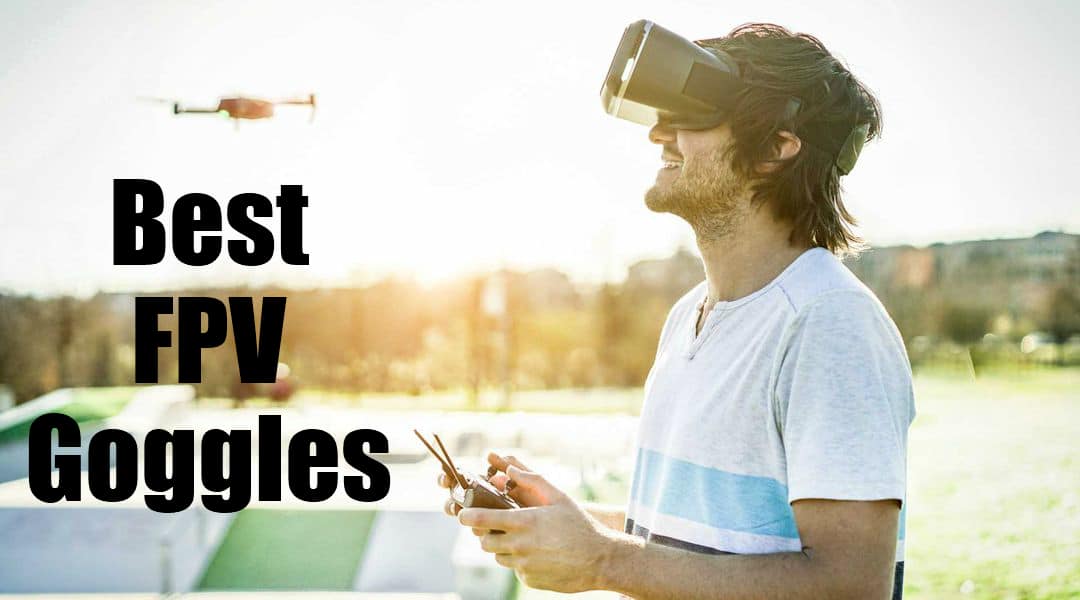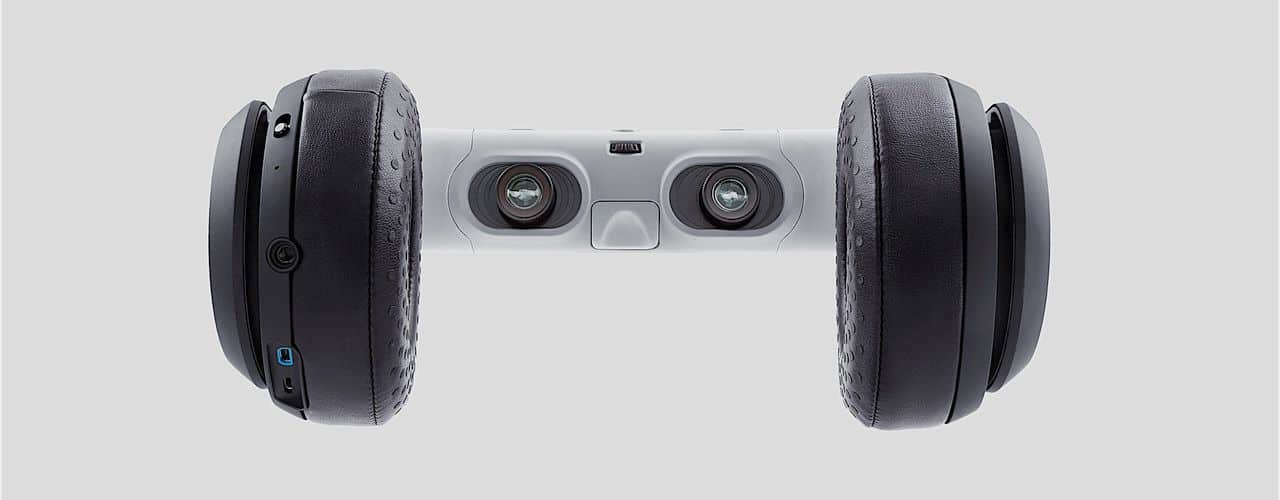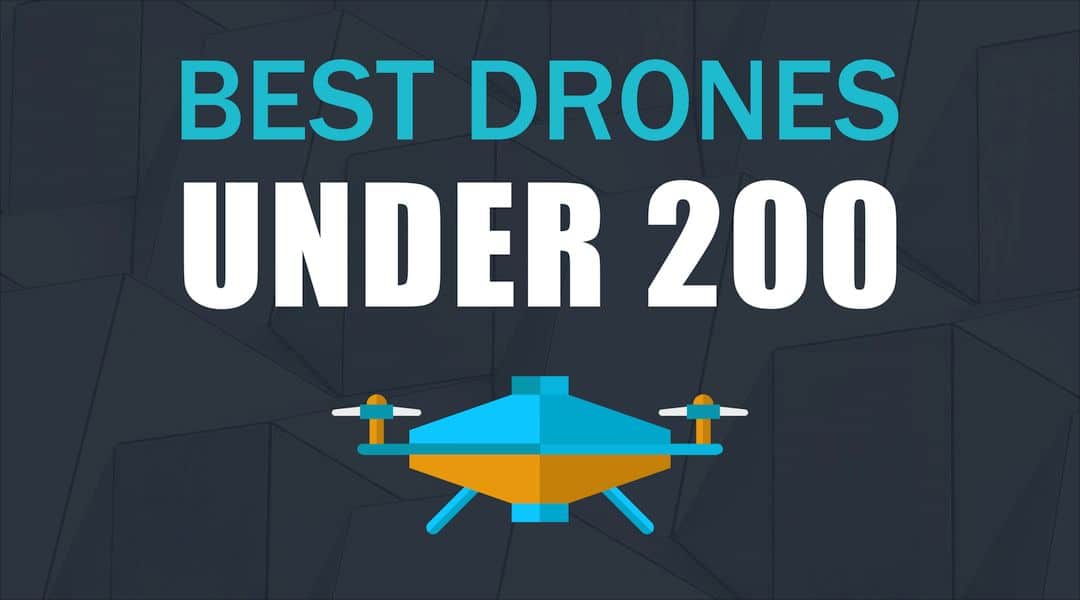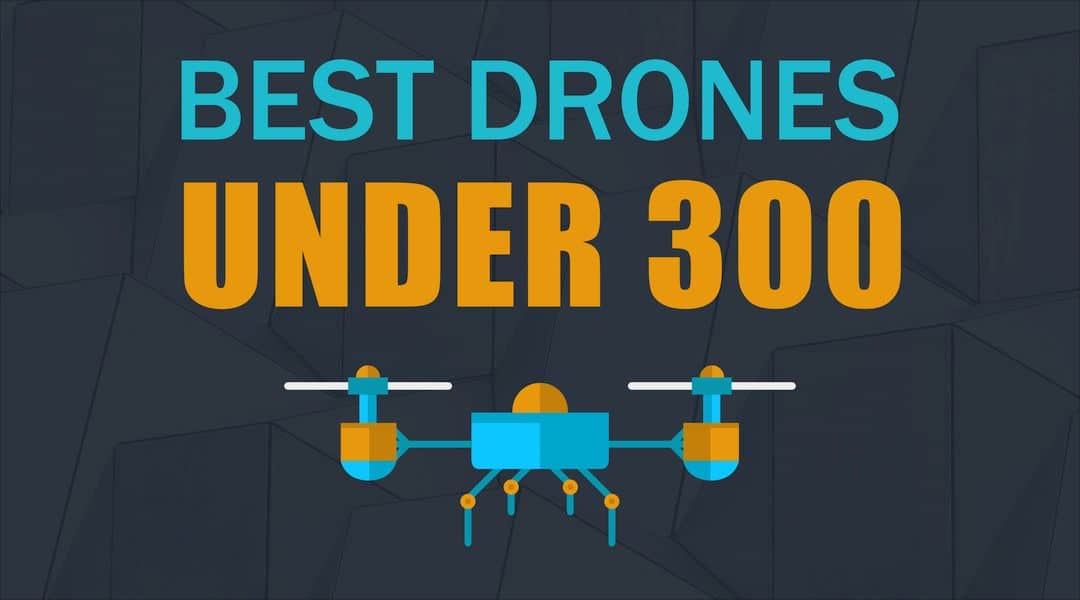The Best FPV Goggles for Drone Pilots

Our Top Pick
FatShark Dominator V3
No products found.
No products found.


Best FPV Goggles
The world has totally evolved, with the technology getting to heights never thought as practical before. In fact, activities like gaming used to be boring and unattractive to most people, before technology came in and changed everything. One such form of technology is remotely controlling devices like drones when racing out with friends, during your free time with one of these best FPV goggles.
However, even as much as piloting a racing drone seems to be a fun activity, it still lacks something to offer the exceptional experience that would make you enjoy the racing more. This is where devices like First Person View (FPV) Goggles come in to bring in the first-hand experience when engaging in drone racing.
They immerse you fully in the racing so that you can enjoy every bit of it. As such, you may need to know more about First Person View(FPV) Goggles, and how you can choose the best, to get a quality experience when flying your drone. Read on to discover the various tips you should consider when choosing your FPV Goggles:
IPD Adjustment
IPD means Interpupillary Distance, which is simply the distance between the centers of the pupils of your eyes. You need to make sure that the goggles you choose are adjustable while considering the involved distance, no matter how big or small. Besides, we all have unique faces, which also have different Interpupillary Distances. When the IPD is not adjustable, the image may look distorted because your pupils are not aligned to the image entry points on the goggles.
Goggle Resolution
There is no need to overemphasize on this point, as it seems almost basic to most people. In short, the resolution at this point is similar to that of a standard monitor, which means that the higher the resolution, the clearer you images will be. The only setback regarding resolution which you may come across when buying FPV Goggles is that the higher the image resolution, the more you will have to spend. There are four most common resolution groups that include QVGA(320×420 pixels), VGA(640×480 pixels), SVGA(800×600 pixels), and FWVGA(854×480 Pixels). The most common resolutions from the group are VGA and SVGA, as the goggles with such are also quite affordable.
Aspect Ratio
This is also another screen aspect that is somehow related to resolution, with the most common aspect ratios for FPV Goggles falling under 16:9 and 4:3. There is also the ratio 5:3, which is not as common as the other two, even though 5:3 (1.666) is closer to 16:9 (1.777). The FPV camera on your drone is either 16:9 or 4:3, which is why you need to ensure that the FPV goggles you choose match the aspect ratio of the camera, to get perfect image results. The most common cameras fall under the 4:3 ratio, though there are also the ones under the 16:9 ratio.
Field Of View (F.O.V)
The angles of view, in this case, is the angle that the center of your eyes makes with the edges of the screens of your goggles. For most of the FPV Goggles, expect a Field Of View ranging between 25 and 45, while the more expensive glasses have a higher FOV. In other words, more expensive goggles will have a better immersive experience, since they will have a higher Field Of View. However, you should learn to differentiate the camera FOV with the goggles FOV.
Video Recording
Imagine a situation whereby your drone has crashed and you need to find it, or you have seen something you may want to share with your friends. In such a case, video recording comes in handy, so that you can have a preview of your flying. The best FPV Goggles can allow you to keep some records of your flight video on something like a micro SD card. There are even others that will enable you to replay an event right on the goggle screens. As expected, such FPV goggles will be quite expensive in comparison to the regular ones.
Video Receiver Frequency
The video receiver frequency is also another important consideration you need to make when buying your FPV Goggles since this is a major determinant of whether you will be able to get past various obstacles such as walls. The main frequencies you can choose from range from 900 MHz, 1.2 GHz, all the way to 5.8 GHz. Most drone experts suggest that a lower frequency is essential if you want to penetrate obstacles or objects such as walls, trees, and others. You might, however, need to know whether the frequency you choose is legal in your country. Take, for example, 900MHz which is illegal in various countries. You should avoid choosing such frequencies to operate with, as such choices may land you in trouble. The most preferred video frequencies for most users range between 2.8 – 5.8 GHz.
Head Tracking technology
This is one of the most exciting technologies that have been employed to drone piloting. It allows the FPV camera to be controlled by the head movements of the pilot. In other words, when the pilot turns their head to the left, the camera is also tilted to the left. When the pilot’s head is turned right, up, and down, the camera will mimic the movements and turn accordingly. However, this feature is commonly available for the more expensive drones.
Piloting Range
There is usually a certain distance for which you can operate your drone without facing any challenges, even though this depends on the transmission tools position and their power. For most FPV Goggles, expect to receive a reliable video feedback for up to a 200m range without any issues. However, other high-quality FPV goggles will have a longer range for which they can receive the video from the mounted FPV camera.
Price
As you probably are aware, high-quality devices are usually more expensive in comparison to other regular equipment, which is why you need to invest more in your FPV goggles, if you want to have the best experience. All you need to do is consider what you want to use your drone for (Racing, hobby, light flying, etc.), and decide on the flexibility of your budget that way.
Color
As much as this may look quite personal, it could also be a major decision to make, considering things like the environment you have. When piloting your drone in the sun, you don’t want your dark goggles to absorb a lot of heat and make you feel uncomfortable. In such cases, you may consider getting light-colored goggles.

Best FPV Goggles Comparison
No products found.

Best FPV Goggles Reviews

1. FatShark Dominator V3 Goggles Review
No products found.
No products found.
- Multiple video formats
- Excellent battery time
- HDMI multiple formats
- Goggles fog up
- Not good with glasses
- No charger included
The Dominator V3 is the latest FPV goggles by Fat Shark, in the Dominator series of products. You will have an amazing immersive flying experience with the first person view (FPV) of the video stream from your quadcopter.
The Dominator has a 16:9 display format and has a mini HDMI port which will give you 720p connectivity. There is a great power backup feature that will write existing files if the power gets disconnected while streaming. Also, you can swap between NTSC and PAL formats easily.
The module bay on the Fathshark allows you to swap in a 5.8 GHz, 2.4GHz, or 1.3 GHz module receiver, so you can receive video on any of these frequencies. This also means you can upgrade your FPV goggles by getting an improved frequency module. However, if you are starting out, you can simply go with the recommended Fatshark receiver modules. To install a receiver module, you simply remove the door panel, put in the module, and snap the door panel closed.
If you have a good FPV camera mounted on your drone, you can control the pan, tilt and roll of the camera using the motion of the headset. This is done by utilizing a head tracker module that can be inserted into the FPV goggles.
Goggle power is provided by an 1800 mAh batter which sits in a head strap pocket on the headset. Included with the headset is a DC power cable, an AV cable, and a carrying case. This headset is the best FPV goggles you will find.
No products found.

2. Eachine EV800 Goggles Review
No products found.
No products found.
- Good battery life
- Highly adjustable strap
- Very affordable
- Heavy goggles
- No DVR option
- No foam padding
You’ll be sure to recognize the Eachine name from the numerous drones and quadcopters they have on the market. These drone range in application from racing, to leisure, to filming.
The Eachine EV 800 goggles is a headset that can serve multiple purposes. It has a 5 inch screen with a low refresh rate that will not be taxing on your eyes while you are flying. This headset operates at 5.8 GHz which is a popular frequency used on most FPV drones.
These goggles do not support advanced features that can be found on other FPV headsets. However, what it excels at is the ability to adapt to the preference and requirements of drone pilots. The headset can be broken down, and the screen can be used as a small monitor.
This headset obviously works very well with the FPV line of Eachine racing drones. Even at high speed flight, this FPV headset is able to accommodate the speeds without motion or side blur. This is important for the pilot so you can clearly see where you are going even at high speeds.
The large screen on this headset has a resolution of 800 x 400 and is powered by a 2000 mAh battery which will give you about 3.5 hours of use. You can also use an external power source such as a 3S or 2S battery.
The power, menu, auto-search, and channel selection buttons are found on top of the headset, along with a connector for the antenna.
No products found.

3. Avegant Glyph Goggles Review
No products found.
No products found.
- Very clear image
- Great sound quality
- Immersive viewing experience
- Feels heavy to wear
- Odd looking design
- Battery could be better
The Avegant Glyph at first glance looks like a slightly oversized headphone, but it gives you much more functionality. This video headset will function as your very own portable and wearable cinema.
As good as this headset is, it does not function as a virtual reality headset, and does not fill your entire field of view. What it does, is simulate a watching a very large screen TV located about 2 meters in front of you.
The Avegant Glyph uses DLP innovative optical technology and micromirrors to beam an image directly into your eyes. The resultant 720p image is brighter and crisper than using two small screens in front of your eyes. You will find less distortion and pixilation in the image.
It is important to note that the DLP projectors are only 720p resolution. However, the lack of pixilation and improved image quality means you will not be able to tell the difference.
You can use the Glyph as a regular set of headphones, or move the device forward to use the video projectors. You can extend the video lenses for viewing by pressing the center button. You adjust the individual lenses for a more customized viewing experience. This allows adjustments for your individual eyes.
The trick to using the Avegant Glyph is using the right nose guard for a comfortable fit. You get a few nose guards, so you can find the right fit. You also get a headband that goes on the top of your head in case you find the Glyph too heavy. The Avegant Glyph is one of the best fpv goggles available on the market.
No products found.

4. FatShark Teleporter V4 Goggles Review
No products found.
No products found.
- Solid Build Quality
- Cary Case included
- Not too heavy
- Small FOV angle
- Charger not included
- Possible static at range
This is a great system for anyone who is looking to get start with FPV drone flying. Yes, there are cheaper models available, but this headset has very easy setup. You mount your camera, attach the VTX plug, and put in a charged battery, and you are ready to fly.
The Fat Shark FPV goggles are known for their reliability and quality. This is the best FPV goggle headset in this price range. However, at this price point you are not going to get premium features like support for 3D camera, built-in SD cards, or DVR flight recording.
The video resolution is only 320 x 240 with a narrow 25 degree field of view. So when you are flying, its best not to be looking around too much, or else your drone may go crashing into a tree.
This headset has a solid build. It doesn’t feel heavy, but is not made from flimsy materials. There is a thick strap that holds the headset firmly on your head. The buttons are located in the center of the goggles and are raised for easy access and use.
This headset also supports head tracking with the purchase of some additional equipment. With head tracking, you can control the camera pointing direction by rotating your head.
One of the coolest features of the Teleporter V4 headset is digital head tracking. Digital head tracking lets you look around the environment your model is flying through without the extra weight and complexity of a mechanical camera gimbal. Special sensors and software in the headset allow you to pan and tilt your field of view using the fixed-position camera.
No products found.

5. Virhuck LS-800D Goggles Review
No products found.
No products found.
- Comfortable to wear
- Good field of view
- Nice finished look
- Some video lag
- Range could be better
- May fog up
The LS-800D is an entry level headset for FPV flying that has dual antennas and a video recorder. This headset has a compact design, unlike other affordable single screen FPV headsets. The weigh and bulk is reduced through the use of a rubber coating enveloping the entire body. The rubber coating ensures that you will have a good grip, and also gives it a nice finished look.
The three included headstraps work well, and are adjustable to give you a comfortable fit. The face pads could be a bit thicker, but still feel comfortable when worn. The light weight of this headset makes it comfortable to wear for long periods.
This headset has a tripod mounting hole at the bottom so that you can convert the headset into a stand alone FPV monitor. Simply slide the portion of the headset that holds the screen, leaving only the monitor.
The view is full screen at 854 x 480 pixel resolution, but the video recording resolution is 720 x 576 pixels.
This headset features dual antennas that provide both omnidirectional, and directional signal reception. This is accomplished by the 12 dBi cloverleaf antenna, and a 14dBi panel antenna. This combination gives you improved signal reception and quality.
This headset is powered by a built in 3.7 V 2000 mAh battery which takes about 4.5 hours to charge. You do not have an option to plug in a battery backup. This isn’t that big of a problem, since on a full charge you can get about 2 hours of headset use.
Given this headset’s affordability and features, it is one of the best FPV goggles available.
No products found.

Best FPV Goggles Summary
Summary
FPV drone racing is highly popular. This is where devices like the best FPV goggles come in to bring in the exciting world of drone racing. Wearing one of these goggles give you an amazing direct view of the camera feed and makes you feel like you are actually flying. Now setting up an FPV system is simple.





